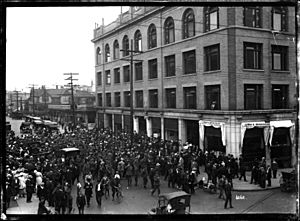1918 Vancouver general strike facts for kids
The Vancouver general strike on August 2, 1918, was a very important event. It was the first time workers across Canada stopped working together to protest. This strike happened because people were upset about several things. These included the government making men join the army, stopping socialist newspapers, and workers wanting better pay. During World War I, prices for everyday items went up a lot. This meant that even if workers earned the same amount, their money bought less. Vancouver shipbuilders also needed more workers, but there weren't enough.
The government had rules that made it hard for workers to protest. They stopped strikes and even banned some newspapers. But workers were also inspired by big changes happening in the world, like the Bolshevik Revolution in Russia. They also saw the cost of living go up, making it harder to afford things. The strike was planned as a one-day protest after a labour activist named Albert "Ginger" Goodwin was killed on July 27. He had said that workers should strike if anyone was forced to join the army against their will.
What Happened During the Strike?
The strike faced strong opposition, especially from soldiers who had returned from the war. These soldiers were given vehicles and sent to the Labour Temple, a building where workers' groups met. Some people claimed the strike was part of a "Bolshevik conspiracy," meaning they thought it was a secret plan by communists.
About 300 men entered the Labour Temple and searched the offices of the Vancouver Trades and Labour Council (VTLC). They tried to throw Victor Midgely, the VTLC secretary, out of a window. The soldiers then forced him and another worker to kiss the Union Jack, which is the flag of the United Kingdom. A woman working in the office was also hurt when she tried to stop them from throwing Midgely out the window. Helena Gutteridge, a well-known supporter of women's right to vote and a member of the VTLC, was also there.
How Did People React to the Strike?
Before the strike, the leaders of the Vancouver Trades and Labour Council voted to support it. The vote was 117 to 1, showing that most worker representatives agreed with the strike.
After the strike, some business owners and middle-class people were very upset. Because of this, all the strike leaders offered to resign from their positions. However, almost all of them were re-elected in the next election. This showed that many organized workers strongly supported the general strike.
What Was the Impact of the Strike?
Even though the call for a strike went out across the whole province, it was mostly in Vancouver that it became a "general strike." Many other strikes happened in Vancouver that year. The general strike was a way for workers to show how strong they were. It was also a political protest against Ginger Goodwin's death.
At the time, people had different opinions about the strike. Some saw Ginger Goodwin as a hero for the labour movement. Others thought the strike was wrong and went against Canadian values. Even though it lasted only one day, the 1918 strike was an important part of the "Canadian Labour Revolt." This was a time when workers across Canada protested a lot, and it reached its peak with the Winnipeg General Strike the next year. A strike in Vancouver in 1919, which supported the Winnipeg strike, is still the longest general strike in Canadian history.


